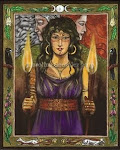
I love crafting and creating different things for each Sabbat. I feel it connects me to the energy of that particular Sabbats meaning, and that time of year. Of course at Imbolc the Goddess Brigid is honored, and there are many things you can create in her honor.
The Brigid's cross is well known and one of her sacred symbols. You can make these easily with pipe cleaners. Or, if you want to be more authentic, you can make them out of reeds which is the traditional material used. Making a Brigid's cross with reeds is a little more difficult, but the results are worth it, and I always think its a good idea to be authentic as often as possible. Here you can find instructions on how to make a Brigid's cross using either material : How to make a Brigids cross.
The symbolism of the cross comes from a tale of St Brigid or "Mary of the Gael"who was born in the 5th century CE. She was the daughter of Dubhtach, a Leinster Pagan chieftain. When her father was dying, she sat in prayer beside him, and passed the time by weaving the first St. Brigid's Cross from the rushes strewn about the floor. Her father seeing the cross asked her to explain its meaning and was so overwhelmed that he became a Christian before his death.For centuries, it has been customary on the eve of her sacred festival for the Irish to make a Brigid's Cross of straw or rushes and place it inside the house, or over the door. They saw this symbol as protection for their home and loved ones.
There is also food and drinks you can make to represent the sacred day of Brigid. I always like to make different drinks, so I decided to post one here.
Love Potion Mead
* 1 bottle of honey mead
* 3.5 oz Green Tea
* 1 oz dried Juniper Berries, crushed
* 1 oz Mugwort, crushed
* 1 oz dried Orange Peel, chopped
* 1/2 oz dried Damiana leaf, crushed
Combine all of the ingredients in a large pot or slow cooker. Cook on low-medium heat, stirring occasionally for about 30 minutes. Strain and let sit to cool, then place it in the fridge to get cold. Serve cold and enjoy! This mead is said to be an aphrodisiac!
Find this recipe and many others including Imbolc deserts, breads and dinners at Imbolc Recipes
I hope you enjoy making crafts to honor Brigid and her sacred day of fire!
Photo courtesy of my personal altars and my handmade Brigid's cross







